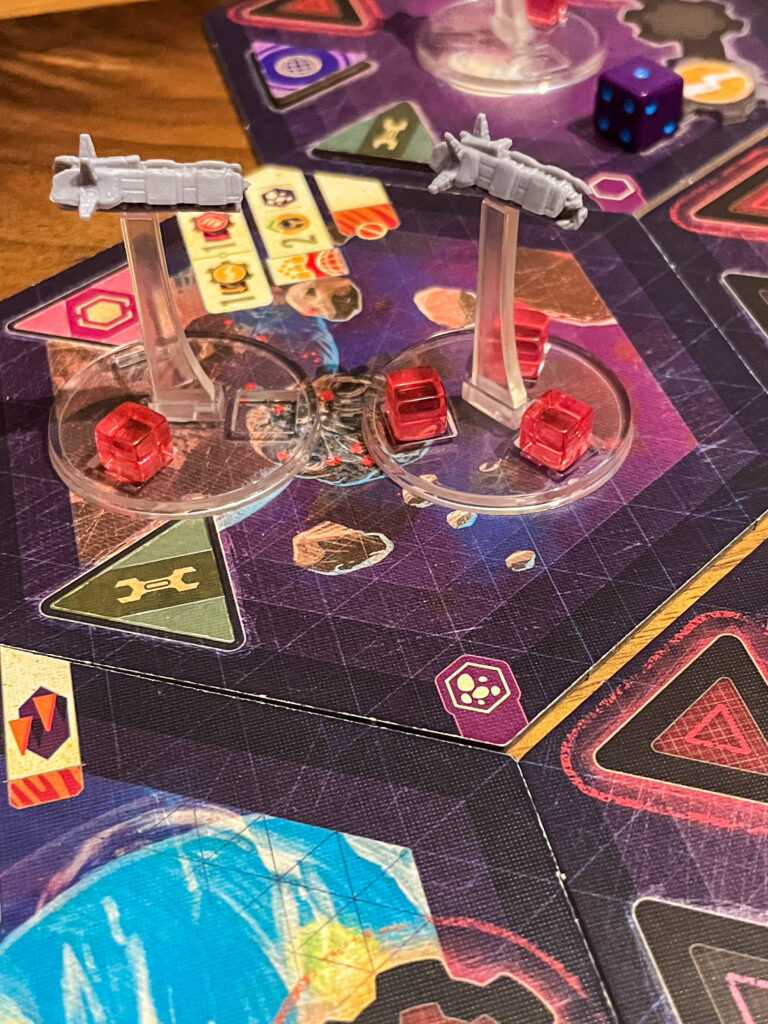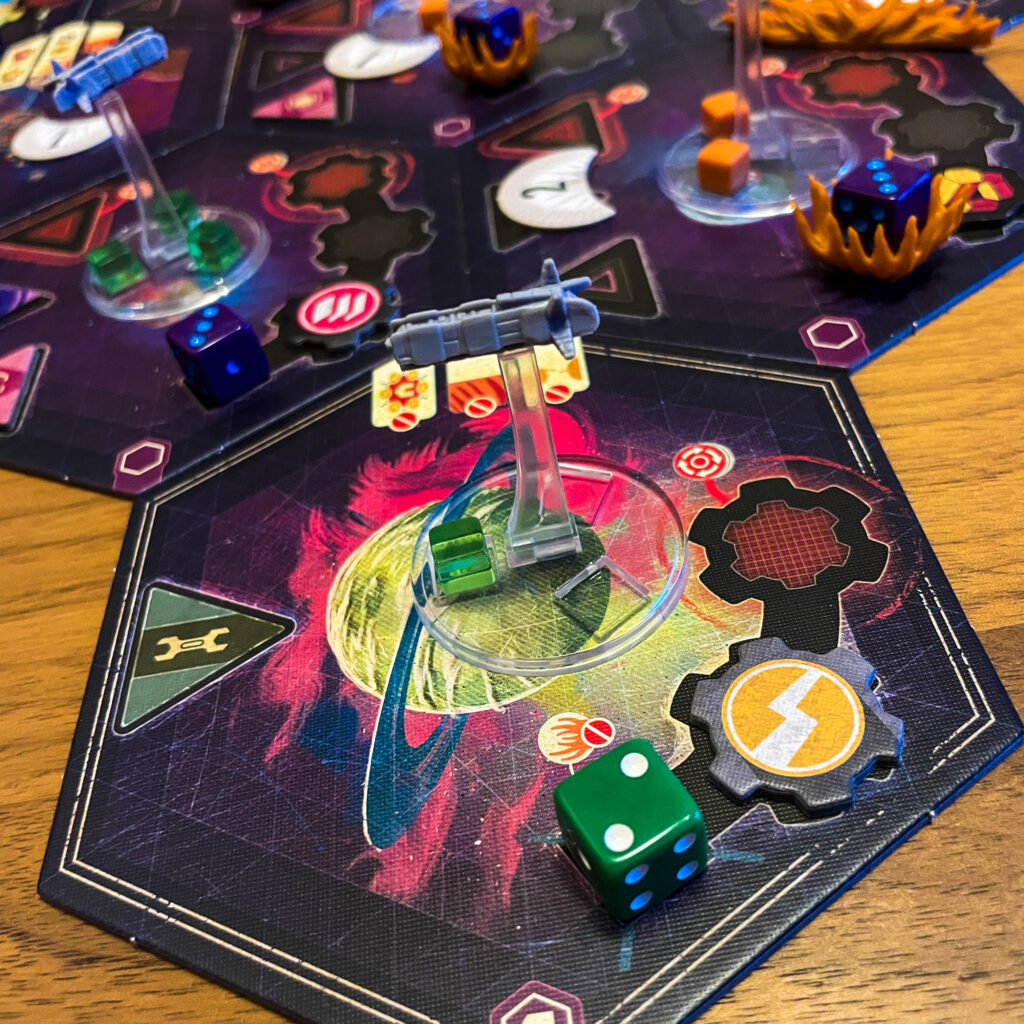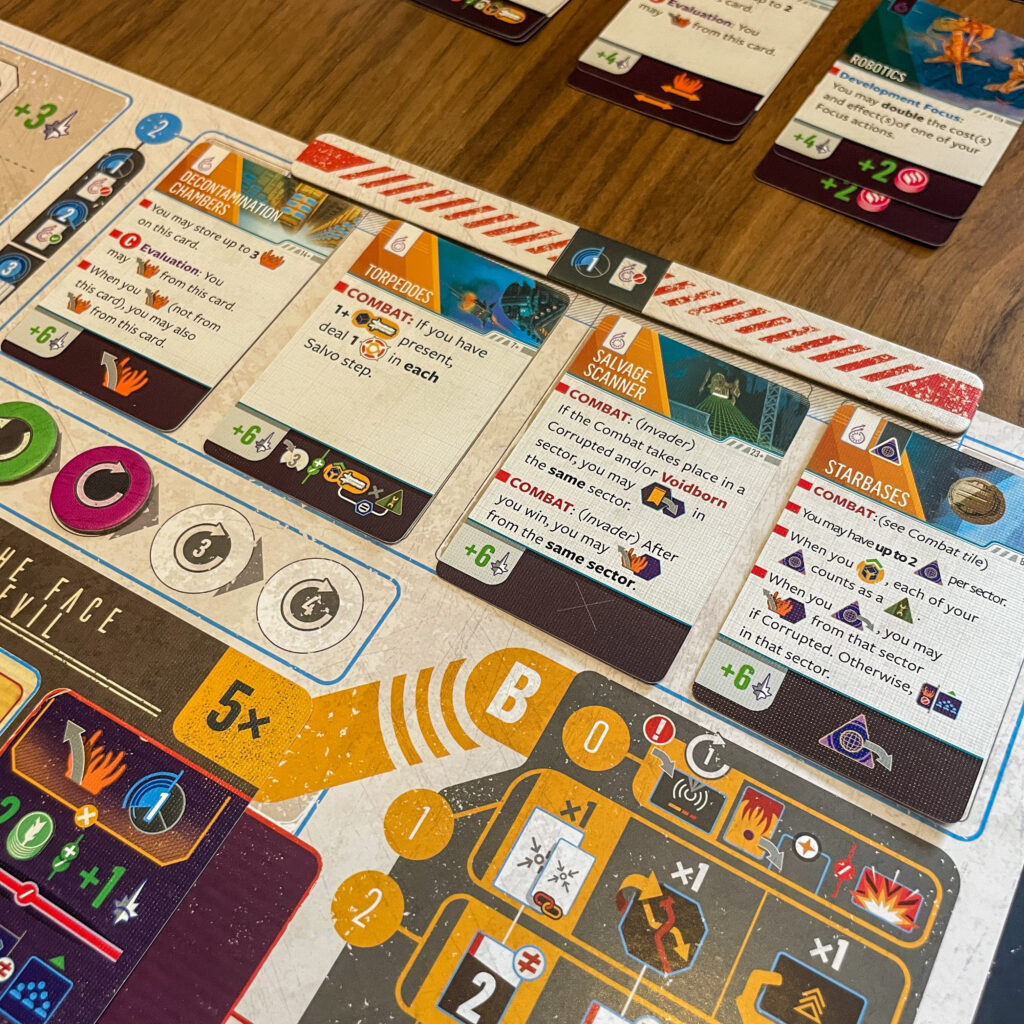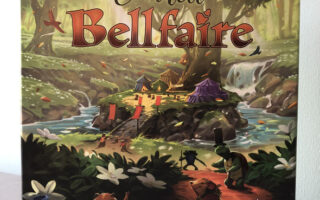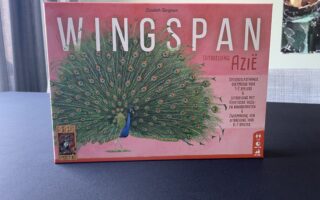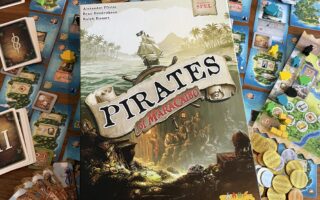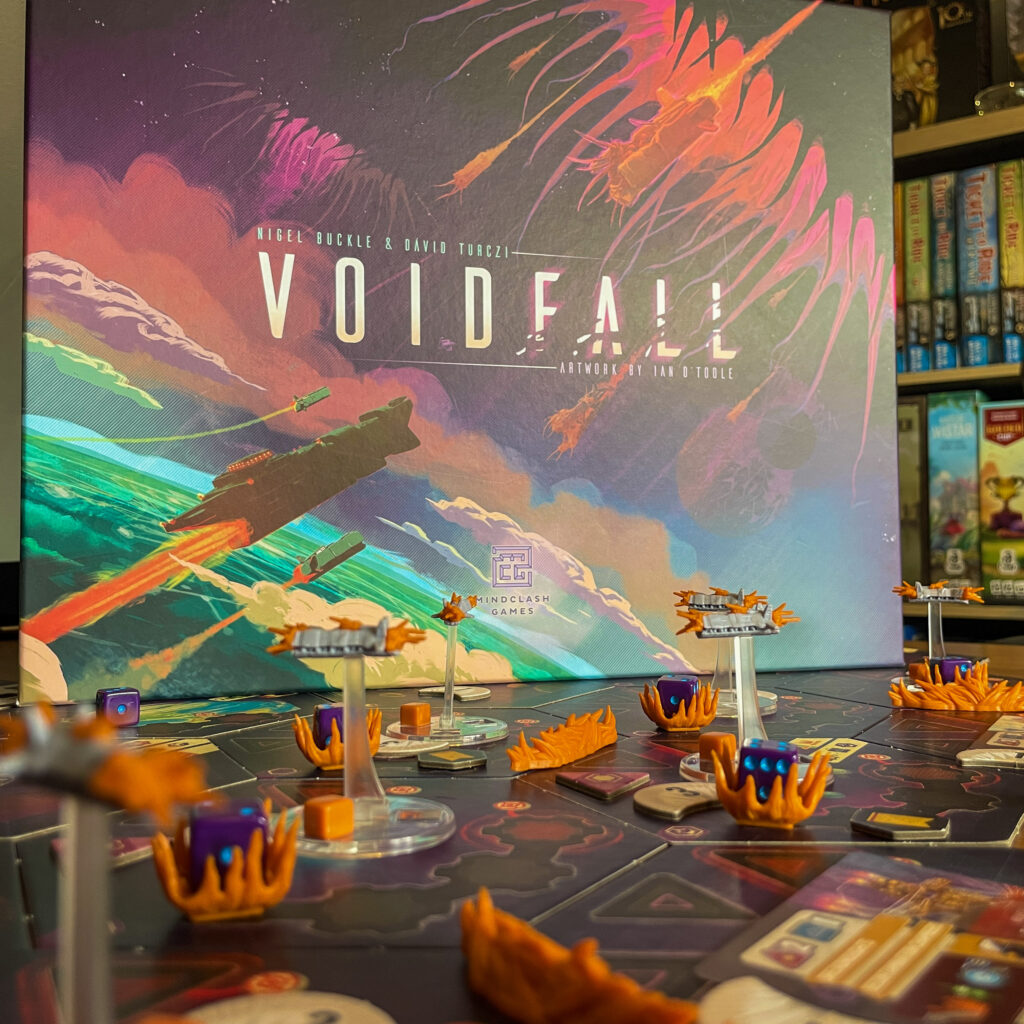
Summary
A game for 1 – 4 players
Playing time is around 90 – 240 minutes
Publisher is Mindclash Games
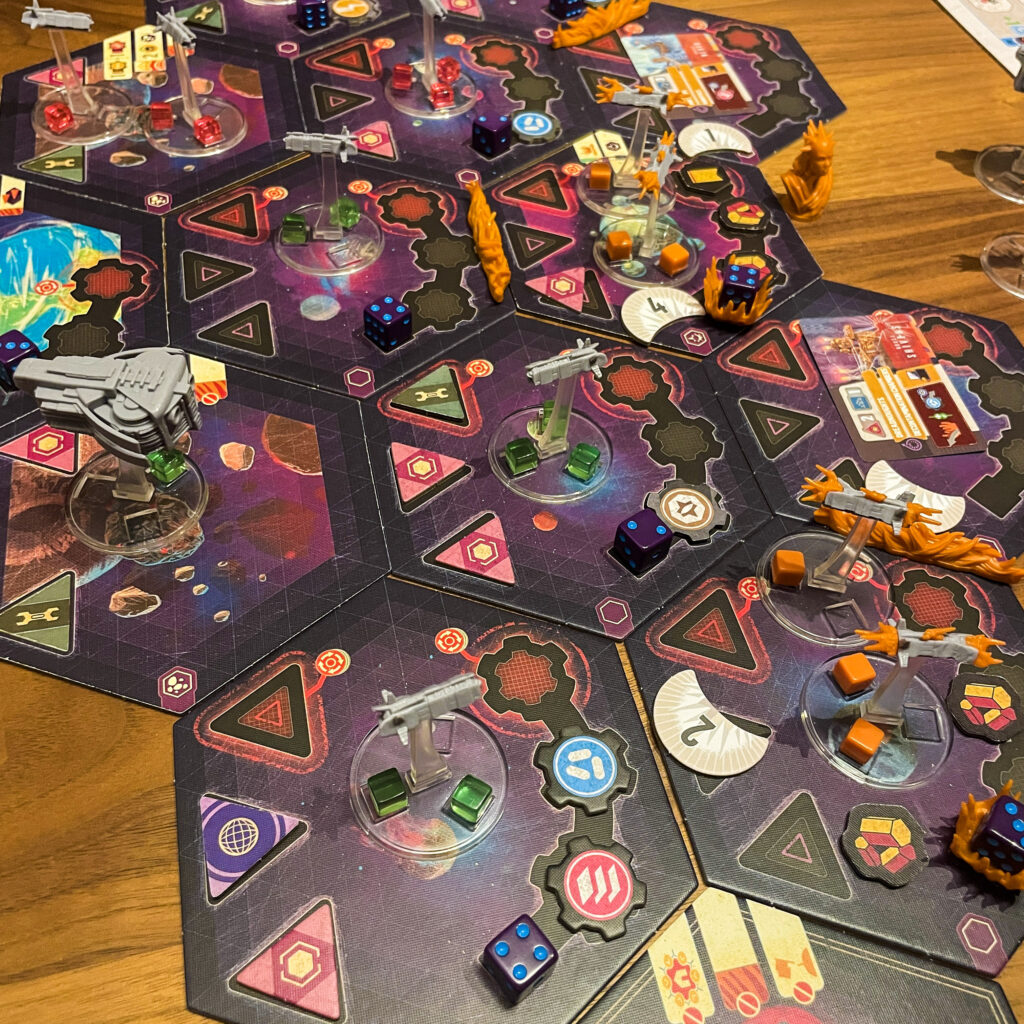
Introduction
In the cold, treacherous reaches of a fallen galactic empire, Voidfall emerges not merely as a game, but as a strategic crucible where the ambitious dare to grasp at control over a civilization teetering on the brink of annihilation.There is no luck to shield you from the consequences of a miscalculation. Every action you take is chosen with surgical precision from your limited pool of Focus cards, modular and multifaceted tools that dictate what your fractured House can accomplish. Empire-building, fleet command, infrastructure development, scientific advancement, political maneuvering, all of it must be managed under the constant threat of the Voidborn, a malevolent force of entropy and corruption threatening to reduce the remains of the Domineum to cosmic ash.
You are the leader of a House once loyal to a crumbling star-spanning regime, now scattered and isolated. Each House is asymmetric, rich in lore and mechanical nuance. Across a modular map of sectors once thriving with trade and governance, you must reclaim and restore — or exploit and dominate. The economic engine you construct must be efficient yet adaptable. The technologies you pursue must synergize with the sparse Focus options available. Your fleets must be built, moved, engaged, but always with limited resources and the shadow of entropy clawing at your borders.
Every cycle (round) of Voidfall is a brutal reckoning. The galaxy decays. The Corruption grows. The Voidborn spreads its tendrils. Public objectives press you for performance. Private agendas pit you subtly against your rivals. The tension is unrelenting, not from random chance, but from the crushing weight of elegantly intertwined systems, grinding against your every decision.
This is not a game of chance.
This is not a game of mercy.
This is Voidfall, masterclass in strategic rigor, dressed in the regalia of cosmic decay.

Let’s get it on the table
To set up Voidfall independently of player count, begin by assembling the sector tiles according to the scenario map.
Place the technology cards in a randomized display to form the tech tableau.
Each player selects or is assigned a House mat, and receives the corresponding components, including fleet markers, influence markers, structure tiles, and starting resources as defined on their mat.
Set the cycle and round trackers to their starting positions.
Shuffle the Galactic Event deck and place it near the play area.
Organize all shared tokens and components, such as population, resources, catastrophe markers, and Voidborn tokens, into central pools for easy access.
Position the agenda deck and structure supply if the scenario requires them.
Players place their home sectors as instructed and populate them with initial structures and fleets. Ensure all player trackers and dials are set to their starting values.
Add any scenario-specific setup elements last, following the scenario’s unique instructions.
Voidfall can be played in three different modes, each offering a distinct experience:
–Competitive, best for players who enjoy deep strategy and engine-building with low-conflict competition.
–Cooperative, best for who enjoy working together to beat a shared, intelligent opponent.
–Solo, best for players who enjoy strategic puzzles and managing a complex AI system.

When players are new to Voidfall, a round will likely move at a slower, more deliberate pace as everyone learns the systems.
At the start of the round, players check the current Galactic Event. This card introduces a temporary rule or effect that applies to all players for the round, and it often influences how players plan their actions. Everyone takes a moment to read it and discuss what it means.
Then, each player chooses one of their Focus cards, these are multi-purpose action cards that let them do things like expand, build, develop technologies, or manage their economy.
Once everyone has chosen a Focus card, they take turns resolving them. A Focus card typically allows a primary action, such as moving fleets into a new sector, initiating combat, constructing buildings, advancing a technology, or managing population.
New players will take their time walking through the action step-by-step, often checking with each other to make sure things are done correctly, especially for combat, which involves comparing stats and sometimes rolling dice, if playing with the standard combat mode.
Players also gain resources, adjust influence, and sometimes trigger special effects from technologies or buildings. These effects can be complex, so newer players might forget them at first or trigger them out of order, part of the learning process.
After everyone has taken their turn using their Focus card, players might adjust any relevant dials or markers, clean up resources, and check whether any sector control or victory point conditions were met.
Rounds continue in this fashion, event, focus card selection, player turns, until the current cycle is complete.
Then players may enter a Cycle end phase, which introduces additional upkeep, scoring, or Voidborn actions depending on the game mode.
Overall, early rounds for new players will be thoughtful and slow, with a lot of rules referencing, strategy discussion, and maybe even some friendly backtracking as players correct missed steps. But the structure of the round is fairly clear and becomes much smoother after the first cycle.
Depending on the play mode and scenario, Voidfall is played in two or three Cycles.
The following steps need to be done at the end of each Cycle:
1. Score Objectives
Players score points for empire objectives, technologies, and other effects.
2. Voidborn Actions (Co-op / Solo only)
The Voidborn expands, spreads corruption, and may attack or complete its own objectives.
3. Reset Focus Cards
Players get back their used Focus cards, unless affected by other rules.
4. Perform Upkeep
Gain or lose resources, adjust dials, and resolve famine or corruption effects.
5. Resolve Special Effects
Trigger any “end of cycle” effects from technologies or structures.
6. Advance the Cycle Marker
Move to the next cycle. If it’s the final one, proceed to final scoring.
Voidborn is the central antagonist in the game, and it represents a dark, corrupting force spreading across the galaxy. It doesn’t act like a traditional player but follows automated rules and behaviors that escalate over time.
This corruption can block player actions, cause famine, and trigger negative effects if left unchecked.
It also expands its influence by placing ships and taking control of sectors. In some scenarios, the Voidborn will build up fleets and launch attacks against player-controlled areas. Its movement and attacks are governed by a behavior deck or specific scenario instructions.
During the end of each cycle, the Voidborn performs a series of actions: it can reinforce its positions, spread corruption further, and attempt to complete its own objectives. If it achieves too many of these goals or overwhelms the players, the team loses the game.
The Voidborn also interferes with objectives and technology access. Some events or actions force players to abandon strategies or lose resources, forcing them to adapt quickly.
Overall, the Voidborn is a growing, automated threat that creates pressure, limits player freedom, and challenges players to work together or plan carefully to overcome its influence before it becomes too powerful.
Players cannot destroy or eliminate the Voidborn entirely, it’s not a traditional enemy to be defeated through combat alone. Instead, they must contain its spread, purge its corruption, and complete objectives that ensure victory despite the Voidborn’s presence.

But yes, players can fight back and “get rid” of the Voidborn’s influence during the game. It’s a battle of strategy, timing, and control, not brute force 😁
Then there are also the Fallen Houses, which are factions that have succumbed to the Voidborn’s corruption, transforming them into formidable adversaries. These corrupted Houses are represented by special Fallen House cards, which are drawn and introduce unique challenges and objectives. Each Fallen House card specifies a particular House that has fallen to the Voidborn, detailing its corrupted traits and the specific threats it poses. These cards are shuffled and drawn at the start of the game, determining which Fallen House will influence the scenario. The presence of a Fallen House adds complexity and urgency, as players must contend with its corrupting influence and the additional objectives it introduces.The game ends and final scoring is triggered when the final cycle is completed.
Now players perform final scoring, which includes:
– Scoring for Empire Objectives achieved throughout the game
– Points from technologies, buildings, and structures controlled
– Bonus points from agenda cards or scenario-specific goals
– Any additional points for territory control and population
In cooperative and solo modes, the endgame also checks whether players have met the victory conditions to defeat the Voidborn, such as completing key objectives or preventing Voidborn domination. Failure to meet these conditions results in a loss.
Once scoring is complete, the player or team with the highest score or who successfully defeated the Voidborn wins the game.
This is how to set up and have the adventure of a lifetime through the galaxy.

Conclusion & final score
Difficulty: 4.64/ 5
Re-playability: 8
Our score: 8 out of 10 dice
Voidfall strikes me as a rich, deep, and well-crafted game with a strong sci-fi theme and lots of strategic layers. It seems to blend classic empire-building mechanics with innovative twists like the Voidborn as an AI antagonist, which is great for variety and replayability.
We like that it emphasizes indirect conflict in competitive mode, focusing on economy and tech rather than constant combat, which can appeal to players who prefer strategy over war. The presence of corruption and the Fallen Houses adds narrative depth and dynamic challenges.
The game’s complexity might be a bit daunting for new players at first, but that’s typical for heavy 4X games.
The modular setup and scenario-driven cycles suggest a well-paced experience that can teach players gradually. Overall, it offers a fresh and thematic approach to space exploration and empire-building that could stand out in the modern board game scene, especially for players who enjoy immersive storytelling and strategic planning.
A Folded Space insert is a valuable addition to Voidfall because it helps organize the many components the game includes. With structured trays and compartments, it becomes much easier to set up and pack away the game, saving time and reducing table clutter. The insert also protects pieces during storage and transport, keeping everything in good condition.
Since Voidfall supports different game modes, having components sorted clearly allows for quicker access depending on the mode being played. For a game as complex and component-heavy as Voidfall, the insert improves both the storage and gameplay experience.
All components in the base game are of very good quality, with well-chosen materials that suit this type of game perfectly. The deluxe Galactic Edition takes it a step further by including miniatures for ships and structures, which are visually appealing. We were privileged to use them in our plays, and they gave the game an extra boost. That said, the standard double-layered ships and structures already do a great job on their own.
Then there’s the artwork, from the famous Ian O’Toole, which gives the game its perfect finishing touch. It sent us into space without even needing a warp hole 😜.
Awesome job! We’ve had a lot of fun during our game nights getting to know Voidfall and feel like it’s truly gotten into our veins.
We want to thank Mindclash Games for this review copy and the opportunity to write about this game.

